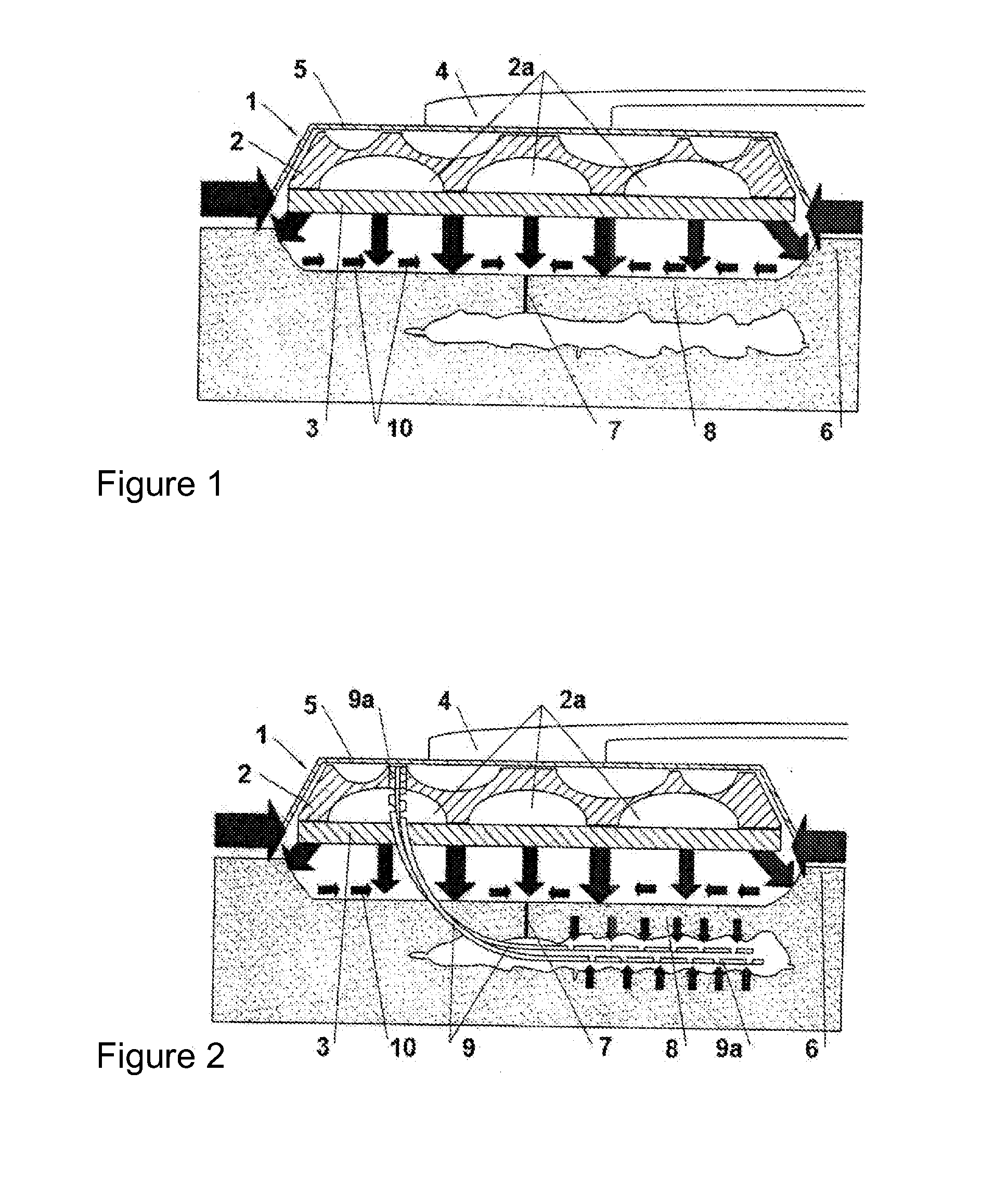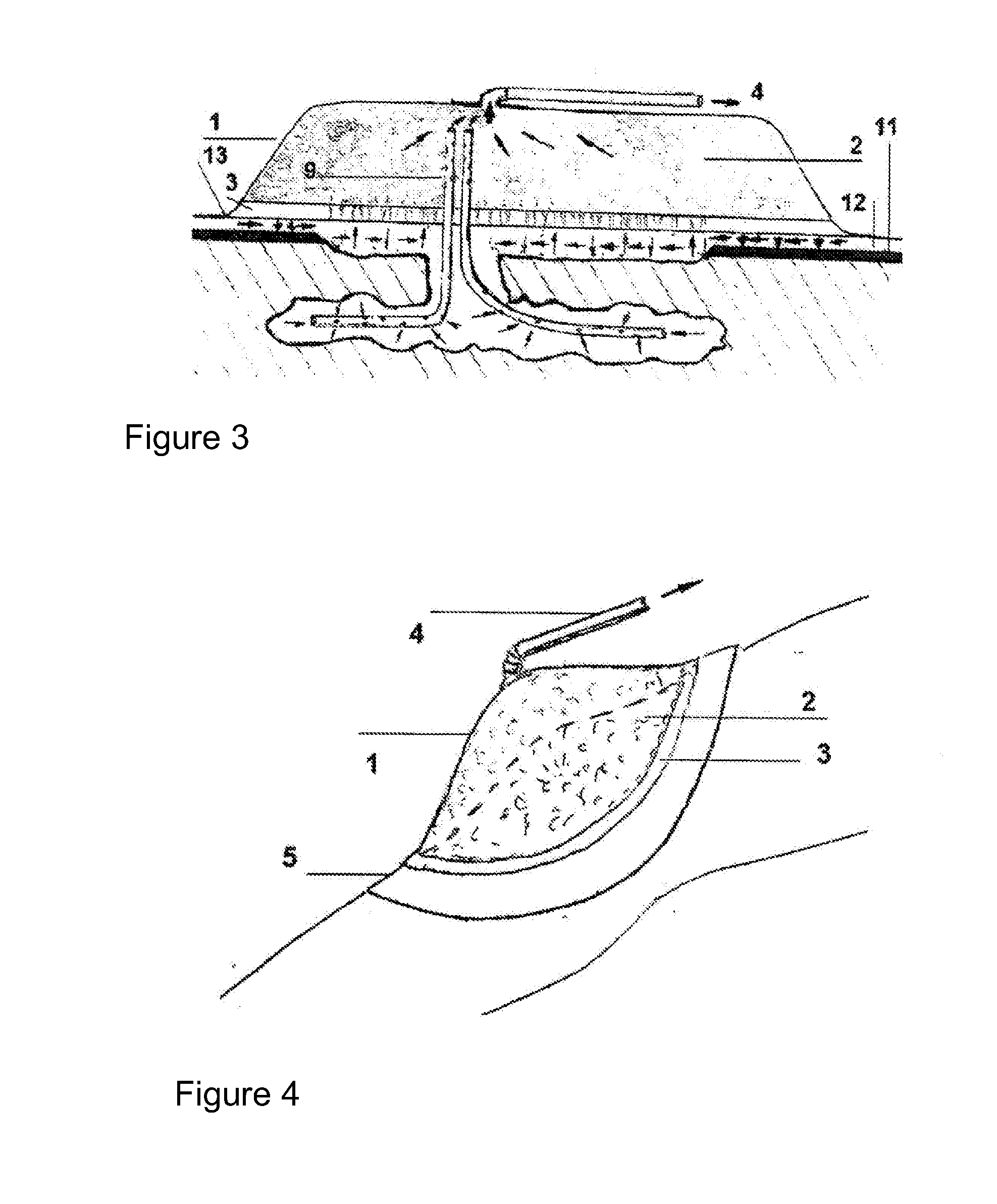Perfecting of the improved vacuum dressing and the use thereof in vacuum-assisted therapy
a technology of vacuum assisted therapy and improved vacuum dressing, which is applied in the field of perfecting the improved vacuum dressing and the use thereof in vacuum assisted therapy, can solve the problems of cvd also entail a loss of opportunity and effectiveness, and the need for more time to be placed, so as to increase the safety or comfort of post-operative treatment
- Summary
- Abstract
- Description
- Claims
- Application Information
AI Technical Summary
Benefits of technology
Problems solved by technology
Method used
Image
Examples
embodiment no 1
Components
[0122]FIG. 1 shows a general configuration for application of the mentioned IVD on a closed surgical wound. Thus, as may be observed in said figures, dressing 1 in question is sealed by means of adhesive film 5 and said dressing is adhered to surrounding skin 7 of the surgical wound, and may even exceed skin 6, which overlies the area of surgical detachment 8; an aspiration tube 4 connected to a vacuum pump, which is not represented, is coupled to said adhesive film.
[0123]Beneath its sealing film, this IVD is essentially composed of two areas, 2 and 3:[0124]an outer component 2, with open pores 2a. [0125]and an inner component 3, with variable permeability, which may or may not be adhesive.
[0126]Both in this FIG. 1, and in the next one, FIG. 2, the following have been marked with arrows: the positive or sagittal compression pressures exerted by outer component 2 and inner component 3 of dressing 1, the tangential centripetal pressures exerted by outer adhesive film 5, whic...
embodiment no.2
Embodiment No. 2
Drainage of Closed Wounds
[0127]The use of IVDs, as compared to traditional bandages and dressings, makes it possible to optimise the reduction of post-operative oedemas, favouring precocious mobilisation and reducing the risk of dehiscences of the surgical wound (i.e. that it re-opens due to precocious mobilisation). Moreover, the system of modified Redon drains 9a of FIG. 2 makes it possible to eliminate the risk of infection associated with the use of traditional external Redon drains.
[0128]Thus, FIG. 2 shows the dressing of FIG. 1, wherein one may observe outer component 2, which has the peculiarity of having a certain thickness that may differ depending on the type of lesion and the area of the surface to be treated; this favours a more effective anti-oedema therapy, and makes it possible to incorporate a drainage device, which, as may be observed in the Figure, is composed of redon drains or tubes 9 that present, in a manufactured manner, a plurality of orifices...
embodiment no.3
Embodiment No. 3
Drainage of Open Wounds
[0130]FIG. 3 shows a schematic view of the IVD of FIGS. 1 and 2, applied to a case of a complex open wound, with loss of substance and dehiscent edges, wherein a drainage device has also been incorporated into the IVD, which consists of redon drains or tubes 9 that present, in a manufactured manner, as in FIG. 2, a plurality of orifices at the two ends thereof; of these ends, one is inserted in the outer open-pore area or component 2, and the opposite end is designed to be inserted in surgical plane 8, such that said tubes 9 directly transmit the reduced pressures from said plane to outer component 2. Moreover, one may observe skin 11, “virtual” space 12, excessively enlarged for clarity, between skin 11 and IC 3, and area 13, where it joins adhesive or non-adhesive inner surface 10 of dressing 1 with adhesive sealing film 5.
[0131]In FIG. 1, as well as in FIGS. 2 and 3, the following have been marked with arrows: the positive or sagittal compre...
PUM
 Login to View More
Login to View More Abstract
Description
Claims
Application Information
 Login to View More
Login to View More - R&D
- Intellectual Property
- Life Sciences
- Materials
- Tech Scout
- Unparalleled Data Quality
- Higher Quality Content
- 60% Fewer Hallucinations
Browse by: Latest US Patents, China's latest patents, Technical Efficacy Thesaurus, Application Domain, Technology Topic, Popular Technical Reports.
© 2025 PatSnap. All rights reserved.Legal|Privacy policy|Modern Slavery Act Transparency Statement|Sitemap|About US| Contact US: help@patsnap.com



